
Juggling is a physical skill, performed by a juggler, involving the manipulation of objects for recreation, entertainment, art or sport. The most recognizable form of juggling is toss juggling. Juggling can be the manipulation of one object or many objects at the same time, most often using one or two hands but also possible with feet. Jugglers often refer to the objects they juggle as props. The most common props are balls, clubs, or rings. Some jugglers use more dramatic objects such as knives, fire torches or chainsaws. The term juggling can also commonly refer to other prop-based manipulation skills, such as diabolo, plate spinning, devil sticks, poi, cigar boxes, contact juggling, hooping, yo-yo, and hat manipulation.
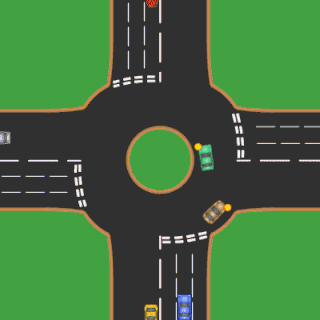
A roundabout is a type of circular intersection or junction in which road traffic is permitted to flow in one direction around a central island, and priority is typically given to traffic already in the junction.

Rodeo is a competitive sport that arose out of the working practices of cattle herding in Spain, Mexico, and later Central America, South America, the United States, Canada, Australia and New Zealand. It was based on the skills required of the working vaqueros and later, cowboys, in what today is the western United States, western Canada, and northern Mexico. Today, it is a sporting event that involves horses and other livestock, designed to test the skill and speed of the cowboys and cowgirls. American style professional rodeos generally comprise the following events: tie-down roping, team roping, steer wrestling, saddle bronc riding, bareback bronc riding, bull riding and barrel racing. The events are divided into two basic categories: the rough stock events and the timed events. Depending on sanctioning organization and region, other events such as breakaway roping, goat tying, and pole bending may also be a part of some rodeos.
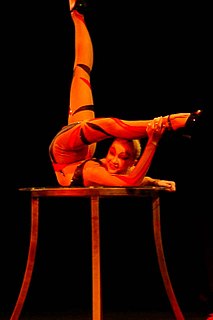
Contortion is a performance art in which performers called contortionists showcase their skills of extreme physical flexibility. Contortion acts often accompany acrobatics, circus acts, street performers and other live performing arts. Contortion acts are typically performed in front of a live audience. An act will showcase one or more artists performing a choreographed set of moves or poses, often to music, which require extreme flexibility. The physical flexibility required to perform such acts greatly exceeds that of the general population. It is the dramatic feats of seemingly inhuman flexibility that captivate audiences.

Acrobatics is the performance of extraordinary human feats of balance, agility, and motor coordination. It can be found in many of the performing arts, sporting events, and martial arts. Acrobatics is most often associated with activities that make extensive use of gymnastic elements, such as acro dance, circus, and gymnastics, but many other athletic activities — such as ballet and diving — may also employ acrobatics. Although acrobatics is most commonly associated with human body performance, it may also apply to other types of performance, such as aerobatics.

Tightrope walking, also called funambulism, is the skill of walking along a thin wire or rope. It has a long tradition in various countries and is commonly associated with the circus. Other skills similar to tightrope walking include slack rope walking and slacklining.
Based in Australia, Circus Oz is the world's longest-running contemporary circus company. Its shows incorporate theatre, satire, rock'n'roll and a uniquely Australian humour.
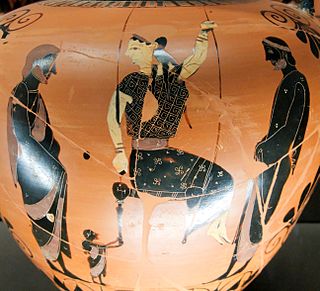
A swing is a hanging seat, often found at playgrounds for children, at a circus for acrobats, or on a porch for relaxing, although they may also be items of indoor furniture, such as the Latin American hammock or the Indian oonjal. The seat of a swing may be suspended from chains or ropes. Once a swing is in motion, it continues to oscillate like a pendulum until external interference or drag brings it to a halt. Swing sets are very popular with children.
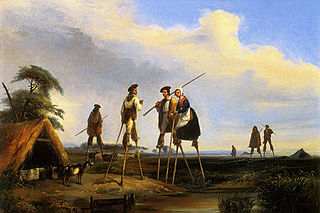
Stilts are poles, posts or pillars used to allow a person or structure to stand at a height above the ground.

Adagio is the performance of partner acrobalance poses and associated movements that involve stationary balances by a pair of performers. It is performed in professional circus, in various dance disciplines including acro dance and ballet, in pair skating, and as a hobby in university circus groups.

The title Moscow State Circus is used for a variety of circuses. Most commonly, it refers to one of the two circus buildings in Moscow, the "Circus Nikulin" and the "Bolshoi Circus", or to traveling shows which may or may not be directly related to Russia.
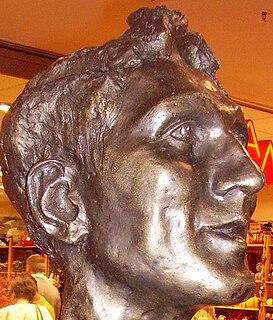
Enrico Rastelli was an Italian juggler, acrobat and performer.
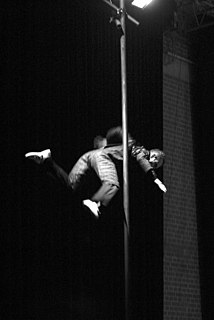
Chinese poles are vertical poles on which circus performers climb, slide down and hold poses. The poles are generally between 3 and 9 metres in height and approximately 2 to 3 inches in diameter. Some poles have a slightly larger pole that rotates around the static central pole using ball bearings. This rotating pole allows a performer to spin on the vertical axis, giving a performer the ability to incorporate rate of spin into what would otherwise be static moves. Bringing the body closer into the pole causes the performer to spin faster. A few Chinese pole tricks have been incorporated with pole dancing techniques.
Object manipulation is a form of dexterity play or performance in which one or more people physically interact with one or more objects. Many object manipulation skills are recognised circus skills. Other object manipulation skills are linked to sport, magic, and everyday objects or practices. Many object manipulation skills use special props made for that purpose: examples include the varied circus props such as balls, clubs, hoops, rings, poi, staff, and devil sticks; magic props such as cards and coins; sports equipment such as nunchaku and footballs. Any other object can also be used for manipulation skills. Object manipulation with ordinary items may be considered to be object manipulation when the object is used out of its socially acknowledged context and used differently from its original purpose.
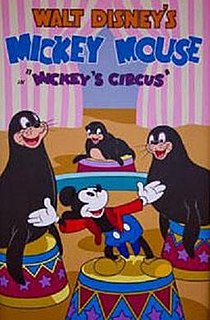
Mickey's Circus is an animated short film produced by Walt Disney Productions and released August 1, 1936. Known crew include director Ben Sharpsteen and animators Milt Kahl, Frank Thomas, Al Eugster, Shamus Culhane, & Errol Gray.
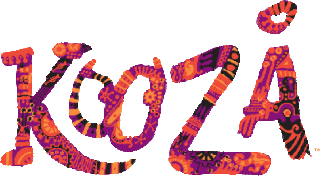
Koozå is a touring circus production by Cirque du Soleil which premiered in Montréal, Quebec, Canada, in 2007. The show was written and directed by David Shiner, who had previously worked as a clown in Cirque du Soleil's production of Nouvelle Expérience. His experience as a clown and his time with Switzerland's Circus Knie and Germany's Circus Roncalli informed his work on Koozå.
Corde lisse is an aerial circus skill or act that involves acrobatics on a vertically hanging rope. The name is French for "smooth rope".
Hand to hand acrobatics is a type of performance in which an acrobatic base and flyer balance on top of each other in either a gymnastic or acrobatic medium. It combines strength, agility, flexibility, and balance. For it to be considered hand to hand acrobatics, the top performer must be making physical contact only with the base’s hands, with her own hands keeping her balanced. Positions the top can perform in this style of acrobatics are straddles, handstands, pikes, press to handstand, one arm handstands, planches, flags, and many others. Hand to hand acrobatics can also include dynamic catches and throws that either begin with a throw from a hand to hand position or end in a catch in the hand to hand position.

Cirque de la Symphonie is a touring circus troupe based in Athens, Georgia, first incorporated in 2005 by William H. Allen and Alexander Streltsov. Its performances involve a variety of minimalist contemporary circus acts synchronized to the music of a live symphony orchestra. Reception to the Cirque has been positive both commercially and critically, with shows typically selling out and being positively reviewed by critics.

















